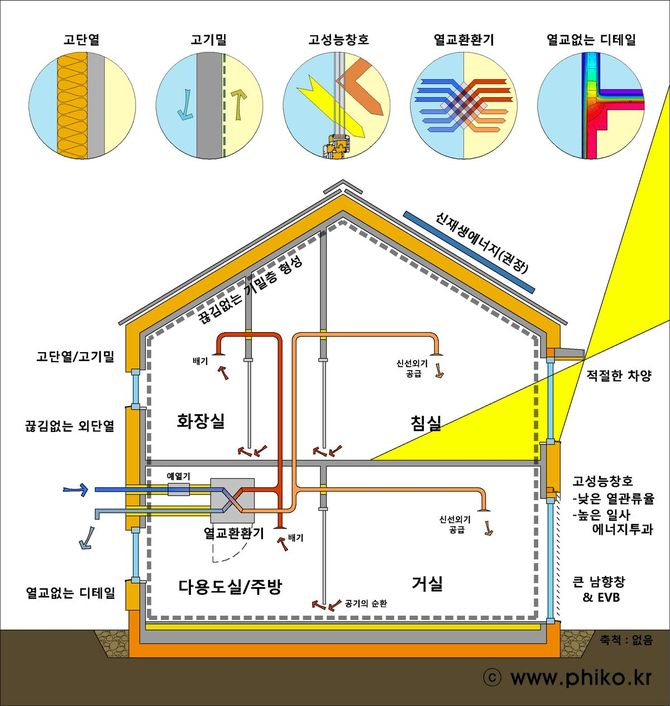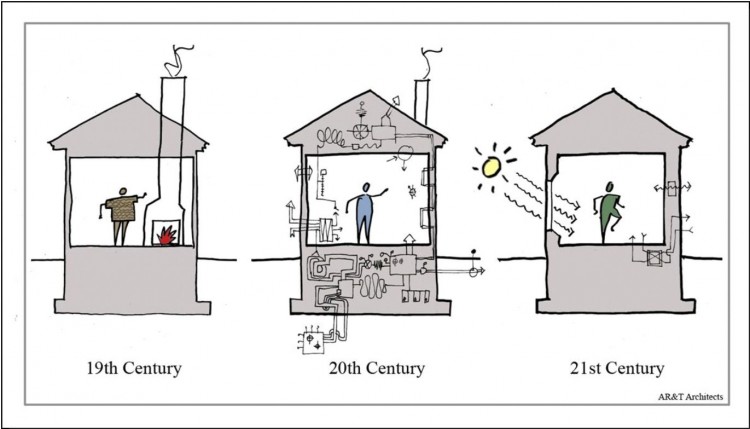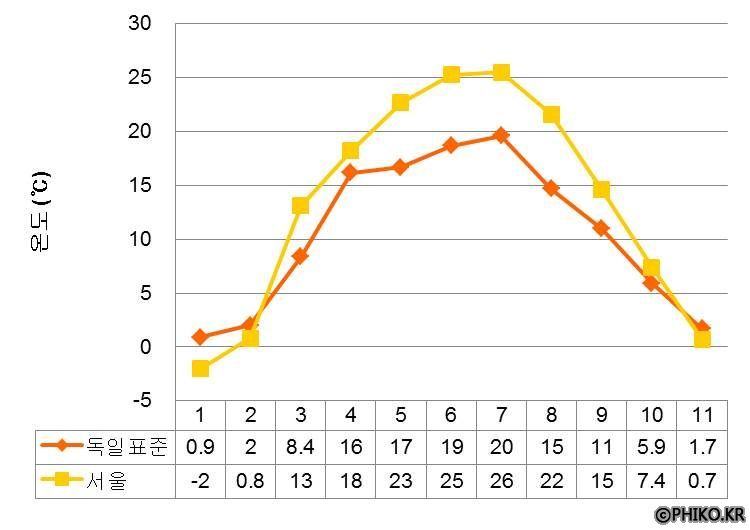기술자료
 E.2-00. PH Definition and Requirements
E.2-00. PH Definition and Requirements
The definition of Passive House is as follows:
Qualitative Definition by PHIKO
A passive house building is one that reuses naturally occurring heat and methods such as shading to mediate solar radiation; has the ability to maintain satisfactory indoor temperature with minimal reliance on equipment; and enough fresh air for living at the perfect temperature such that the occupant is satisfied with thermal and air qualities.
Qualitative Definition by PHI
A passive house is a building that provides sufficient fresh air needed for living without the help of direct mechanical heating equipment; and in which the occupant can slightly raise or lower the temperature of the air with supplementary equipment, for satisfactory thermal and air qualities.
Source: Passivhaus Institut (German) Paraphrased by PHIKO
Recently the following definition has been added.
"It is a standard building that is energy efficient, comfortable and affordable. If one of these three factors is not satisfied, it is not a true passive house."
Source: Passivhaus Institut (German) Paraphrased by PHIKO
Quantitative Definition
Heat Energy Load: less than 15kWh/㎡·a
Primary Energy Use: less than 120kWh/㎡·a (cooling, heating, lighting, hot water, ventilation, electricity)
Maximum Heating Load (Central/Northern Europe): less than 10W/㎡
Maximum Cooling Load (Southern Europe): less than 10W/㎡
| General Category | Description | Performance requirements |
| Exterior Walls | Exterior Wall U-value | Less than 0.15 W/㎡·K (KOREA: 0.18 W/㎡·K) |
| Roof U-value | Less than 0.15 W/㎡·K (KOREA: 0.15 W/㎡·K) | |
| Windows | Glass U-value | Less than 0.8 W/㎡·K (KOREA: 0.8 W/㎡·K) |
| Frame U-value | Less than 0.8 W/㎡·K (KOREA: 1.0 W/㎡·K) | |
Window (Installed) U-value | Less than 1.05 W/㎡·K | |
| Glass g-value (SHGC) | Greater than 0.5 (KOREA: Greater than 0.4) | |
| Doors | Door U-value | Less than 0.8 W/㎡·K |
| Door Airtightness | Less than 0.45 ㎥/㎡·h | |
| HRV | Efficiency | Greater than 75% (Latent heat) |
| Power Consumption | 0.45 W/㎥·h 이하 | |
| Outside Air Requirement | Greater than 0℃ (preheater or geothermal heat exchanger required) | |
Air Supply/Exhaust Ratio Difference | Less than 10% | |
| Thermal Bridges | Linear | Less than 0.01 W/m·K (not strictly applied) |
| Point | Less than 0.01 W/㎡·K 이하 (not strictly applied) | |
Overall Building Performance | Airtightness | Less than 0.6 ACH/h @ 50Pa (KOREA: 1.0 ACH/h @ 50Pa) |
| Efficiency of Home Appliances | Use High-Efficiency Home Appliances | |
| Lighting Load | Use Minimal Lighting Fixtures |
The goal of passive house is to minimize active mechanical systems that consume the most energy, as much as possible, while using passive measures to deliver thermal comfort to the occupant. The ultimate goal is to provide active or direct mechanical equipment only where and when absolutely necessary.
Whether this goal is possible to achieve in Korea is a quest in progress; however, if an understanding of the various prerequisites can be mutually agreed upon, it would seem that achieving the overall goal is entirely possible.
Previously posted under "Project Introduction" in the "Download Data" Bulletin Board, here again is the diagram by an American architect that clearly illustrates the differences between a passive house and houses in the past.
<Source: Albert, Righter & Tittmann Architects, Inc.>
Basis for the Association's Qualitative Definition
The aim of passive houses in Europe is basically to maintain indoor air temperature by controlling the temperature of the incoming air supply with the heat recovery ventilation system. But in Korea, where culturally the radiant floor heating system cannot be eliminated, it is not possible to maintain adequate thermal comfort by solely relying on the HRV to warm or lower the incoming air supply.
Of course there are cases of radiant floor heating in European passive houses, but these are purely supplementary measures. Meaning that floor heating or even radiators are used to raise the air temperature sensed by the body. However, in Korea, even if the air temperature may be in the comfortable range, the temperature of the floor, felt by bare feet, is the primary determinant of comfort and therefore cannot be lowered.
Consequently, since it is not possible to exclude radiant floor heating from any of the living spaces, we included it in our country's passive house standard. And of course, as commercial spaces do not require radiant floor heating, another approach is needed.
So the definition and direction that our association has determined is that naturally occurring heat, such as solar radiation and human body heat, is a principal heat source; mechanical heating to warm the floor, a supplemental heat source; and of its functions, the HRV's primary purpose is to supply fresh air. Of course, this is a cause for tweaks to a portion of the German passive house configuration; however, when the studies are completed, we will be able to say that the Korean Passive House Standard is complete.
This again is the responsibility of the researcher.
For the Exterior Wall Heat Transfer Coefficient of 0.15 W/㎡K, please refer to the following post:
For the basis for the g-value for glass in Korea, please refer to the following post:
-----------------------------------------------------------
Different approaches of Germany and Korea to Ventilation
Of the diagrams used to explain passive house, the one below can be found.

The differing point between this diagram and that of the association is that the HRV receives outdoor air either directly or through a geothermal heat exchanger.
Further explanation will be added in the HRV section; however, during the winter season, if below zero air temperature enters the HRV directly, condensation or freezing may occur in the unit, resulting in supply air that is too cold. So, the outdoor air must be preheated to a certain degree before entering the HRV.
The temperature of the incoming outside air has to be preheated to 0℃ and in the German diagram it appears that the preheating is done via a Cool Tube. There are two reasons why the Cool Tube method is not appropriate in the Korean climate; therefore the association's diagram indicates a preheater.
First, due to the high humidity in the summer, there is a possibility of condensation forming while air passes through the geothermal tubes. If this moisture is not properly treated, it may cause mold spores to generate. And if the construction is not in the least bit precise, groundwater can penetrate the tubes causing the same types of problems.
(At 28℃, the dew point temperature of 85% of the air is at 25.24℃, so condensation occurs at an underground temperature of around 18℃)
Second, the temperature of winter nights in Korea is much lower than in Central Europe, so it is not possible to adequately warm the air with a geothermal heat exchanger. Of course, if we increase the length of the tubes longer than those used in Europe, the problem can be solved; but when you consider pressure losses from friction and so forth, it does not appear to be the best solution.
However, in our archives, we have been monitoring the properly installed cool tubes of [Kolon Global e+ Green Home] demonstration house. When the results emerge we will be able to discuss the possibility of applying cool tubes in Korea.
------------------------------------------------------
Translated by Alice J Choy (ajcblue@gmail.com)
Director of International Relations
AIA, CPHD, LEED AP+ BD+C, KIA

 E.2-00. PH Definition and Requirements
E.2-00. PH Definition and Requirements

